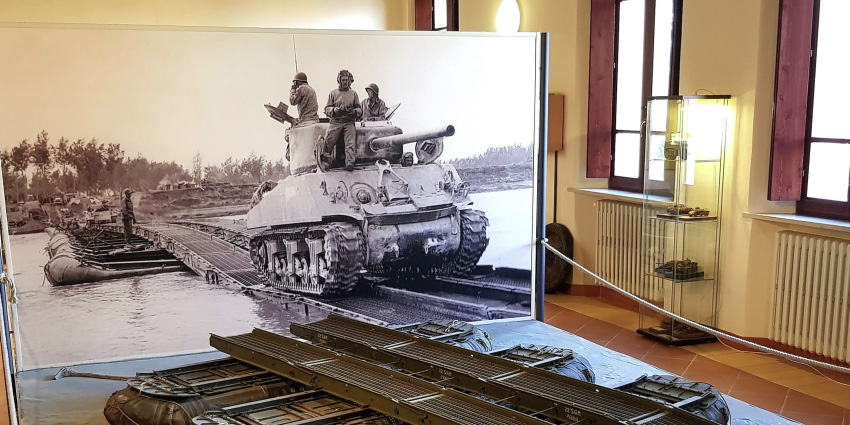
Museum of the Second World War of the River Po: an emotional journey into memory
The Museum of the Second World War of the River Po is a place where history breathes again, where the quiet atmosphere of its rooms seems to preserve the whispers of a turbulent past.
Set within the landscape shaped by Italy’s longest river, the museum stands as both a center of documentation and an emotional experience, capable of awakening reflections, memories, and sensations that connect the present to one of the most significant chapters of the twentieth century.
Here, the memory of the war does not remain confined to dates or events. Instead, it takes on the form of stories—told through objects, testimonies, and fragments of daily life—that reveal the complexity of a territory profoundly marked by conflict. The River Po, with its slow and solemn flow, becomes an invisible guide throughout the visit, reminding the visitor of its historical role as a strategic frontier and silent witness to the dramatic events that unfolded along its banks.
A deeper dive into objects, emotions, and lived experiences
Crossing the threshold of the museum, one is greeted by a delicate balance of silence and presence. The soft lighting enhances the authenticity of each object on display: uniforms worn during harsh winters, military equipment consumed by time, handwritten letters that still retain the emotional intensity of their authors. Every artifact embodies a story, often personal, that transcends the boundaries of the museum and expands into the collective memory.
The exhibition path traces key phases of the Italian campaign, highlighting the strategic importance of the Po Valley during the final operations of the war. Maps, models, and original documents retrace troop movements, the destruction of bridges, and the challenges faced by both soldiers and civilians. The chronological narrative is accompanied by a more intimate dimension: photographs that portray moments of daily resistance, diary entries that reveal fragile hopes, and recordings that preserve voices otherwise destined to fade.
The River Po as guardian and storyteller
Few places can offer a link between geography and history as powerful as the River Po. Within the museum, the presence of the river becomes almost symbolic, a steady and uninterrupted flow connecting past and present. The stories tied to its waters recount the difficulties of crossing it during military operations, the fear hidden behind every strategic decision, and the resilience of communities living along its shores.
The river is presented not merely as a natural element, but as a protagonist in the unfolding of the conflict—at times barrier, at times lifeline, always a silent spectator. Its presence helps shape a narrative that goes beyond the military dimension, highlighting how the landscape itself became part of the war experience.
Personal stories emerging from the shadows of history
Among the most evocative aspects of the museum are the personal accounts woven throughout the exhibition. Letters written in moments of uncertainty, photographs capturing fleeting instants of humanity, and diary pages that reveal the emotional weight of everyday life under wartime conditions—all these pieces create a powerful human connection.
These stories remind the visitor that behind every historical event lie the lives of individuals: young soldiers facing unfamiliar destinies, families forced to adapt to scarcity, children growing up in a world turned upside down. The museum preserves their voices, allowing them to emerge from the shadows and regain a place in collective remembrance.
An immersive approach to historical experience
The Museum of the Second World War of the River Po is designed to offer an experience that is both immersive and reflective. Detailed reconstructions, thematic installations, and carefully arranged displays recreate environments and atmospheres capable of transporting the visitor into the heart of wartime reality. The attention to historical accuracy blends with an emotional narrative that encourages a deeper understanding of the events and their long-lasting consequences.
The experience is enriched by audiovisual materials, original footage, and multimedia segments that deepen the context and provide different perspectives on the conflict. Walking through the museum becomes a gradual journey, where knowledge grows alongside empathy, and where the weight of history is felt not only through facts but through sensations.
A place for reflection, awareness, and the preservation of memory
More than a traditional museum, this space stands as a meeting point between personal memory and historical consciousness. It invites visitors to reflect on the value of peace, the consequences of conflict, and the importance of safeguarding stories that risk being forgotten. The emotional tone that permeates the exhibition encourages a thoughtful gaze, a pause to absorb not just what happened, but how it was experienced by those who lived it.
As the visit comes to an end, the museum leaves an enduring sense of respect—respect for the resilience of the people of the Po Valley, for the sacrifices made in times of uncertainty, and for the lessons that history continues to offer. It becomes clear that memory is not a static concept but a living heritage, passed down through places like this, capable of illuminating the present while honoring the past.




